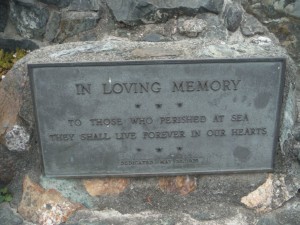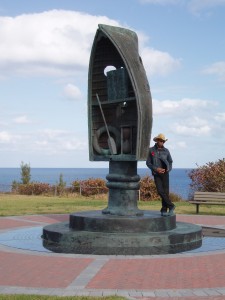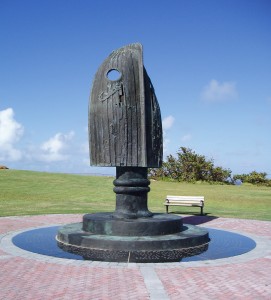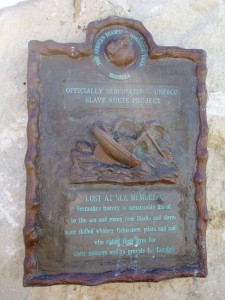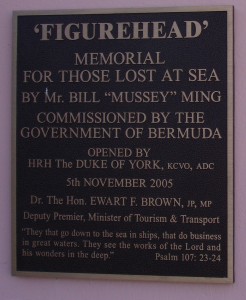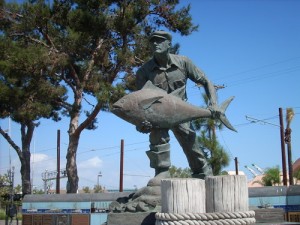Archive for the 'Merchant Marine' Category
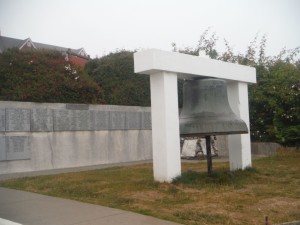 Old friend, former naval officer, and past contributor to this blog Bob Schnell (see March 2011 U.S.S. Roosevelt post) send me the photos for this post.
Old friend, former naval officer, and past contributor to this blog Bob Schnell (see March 2011 U.S.S. Roosevelt post) send me the photos for this post.
Trinidad Head, California is located in Northern California – north of the cities of Eureka and Arcata. The area has a long maritime history, from fishing to the shipping of redwood lumber to the large ports of the west coast. Below the Trinidad Head lighthouse is a memorial to those lost at sea from the local area. One addition to this memorial that I’ve never seen before is the addition of panels of locals who decided to be buried at sea. I think this adds a nice touch to a memorial located at one of the most beautiful spots in California.
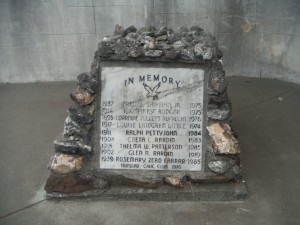
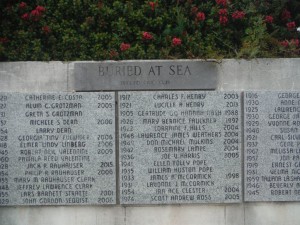
The most enjoyable and satisfying aspect of writing this blog is hearing from strangers commenting on a post or directing my attention to a memorial previously unknown to me. Recently I received an email from Nadia Ming, calling my attention to the Figurehead Memorial on St. David’s Island, Bermuda. My sincere appreciation to her for all the background information for this post. All Photographs in the post are courtesy of Nadia Ming.
The memorial was originally proposed in January 2003, when two fishermen were lost at sea in rough weather. The memorial, by Bermuda artist and native Bill Ming, was dedicated on November 5, 2005 by HRH Prince Andrew, the Duke of York.
I often speculate about the thought process of the artist when writing these posts. This post is special, however, as Nadia Ming provided me with Bill’s original vision for the project.
Maquette for Memorial for Those Lost at Sea
“As an ex-seaman who worked aboard the Queen of Bermuda I felt inspired and motivated to submit my representation of the Memorial for Those Lost at Sea. The theme of maritime life is very close to my art and ideas therefore this sculpture is intended to be a work of commemoration for the known and unknown souls lost to the tides of time yet alive through our memories and chronicles.
This memorial should honour our local fishermen/women who cast their nets and pots to scrape an existence from their catch. Bermudians lost to their loved ones as a result of storms or hurricane and the African slaves who perished during the long arduous Middle Passage.
I have tried to capture these elements, creating the spirit of a beacon that acts as a guiding and welcoming sight in times of storm and calm, a lookout for sailors who sail beyond that horizon of hope.
The form of my sculpture takes the shape of an upturned vessel, which points to the skies and stands erect on a compass due east. Barnacles, shells and a map of Bermuda tattoo the face/mask like limpets clinging to a hulks underbelly. These would stand proud of the surface providing tactile information for people with visual impairments.
Braids of rope frame a cabinet, which houses a paddle for that proverbial creek; an hourglass with sand running out and a life preserver to keep ones head above the water. Overseeing these articles shelters an open logbook that can display the names of all ”Bermudians lost at sea,” alternatively the base could also provide space for names, which would be visually accessible for people in wheelchairs.
I envisage that the final design could be produced in metal (possibly bronze) and/or stone, which would be sympathetic to the site and have durability.”
I believe Mr. Ming captured every element he envisioned in this beautiful memorial. The artist is pictured in the first picture below. I encourage everyone to learn more about Mr. Ming and his art at: http://www.billming.com/index.php
Nadia pointed out two very important additional elements of the memorial in her emails. The first was that The Figurehead Memorial is also part of The African Diaspora Heritage Trail (ADHT), which has been officially designated part of UNESCO Slave Route Project. Take the time to visit the ADHT website at: http://www.adht.bm. I think you will find yourself, like me, spending many fascinating hours learning about “the global narrative of people and culture of African descent” – and the very valuable and important effort to encourage everyone to visit these sites of historical and cultural importance and enrichment.
Information on the UNESCO Slave Route Project can be found at :http://www.unesco.org/new/en/culture/themes/dialogue/the-slave-route.
Men and women of African descent have sailed the oceans since the beginning of recorded history. The earliest known ocean voyages were from Northern Africa to Malta and Crete. During the Great Age of Sail (1600 – 1850) over 20% of all able-bodied seamen were of African descent – some were slaves, but most were free Blacks. Today they still command and crew the warships, merchant vessels, passenger ships and fishing fleets of the world – and daily face the dangers and the majesty of the open ocean.
Approximately 70 names of those lost at sea from Bermuda are engraved at the base of the memorial. All their names can be found at: http://bernews.com/2010/03/lost-at-sea-memorial-full-list-of-names/.
In closing this post, the poem below is inscribed in the open pages of the logbook on the memorial. The poet’s words were inspired by the book of Revelations of St. John the Divine, Chapter 10:5,6 – “And the angel whom I saw standing on the sea and upon the earth lifted up his hand to heaven. And swore by him that liveth for ever and ever, who created heaven and the things that are in it, and the earth and the things that are in it, that time should be no longer.”
THE END OF TIME
“Upon the restless rolling deep
That once the mighty tempest spawned;
Now lies the racing crest asleep.
Beneath that peaceful glassy plain;
All ships and men are there interred;
And all are ‘neath that blanket lain;
Tho’ strove with main now undisturbed.
Beneath that awful silent shroud;
Beneath that fearful mocking stew;
Mingled bone and steel as one
Forever wed as silten brew.
Wreckage, war and nature’s knife;
Trophies piled are theirs to be;
But wills again ‘lasting life,
Victorious, glorious, – NO MORE THE SEA”
By the late Allan E. Doughty Sr. 1922-2013
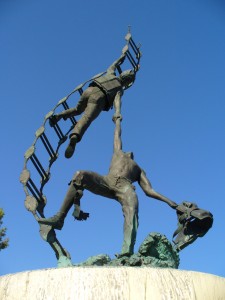 One new photograph revisiting an old post and one new memorial not previously discussed in earlier posts are today’s topics. Both of these memorials can be found near the waterfront in San Pedro, California.
One new photograph revisiting an old post and one new memorial not previously discussed in earlier posts are today’s topics. Both of these memorials can be found near the waterfront in San Pedro, California.
I previously posted a discussion of the impressive Jacob’s Ladder sculpture by Jasper D’Ambrosi. A reader of this blog has graciously provided me with a beautiful photograph of the memorial. Tamara Becker presently serves as a Second Mate and Chief Mate Unlimited on commercial ships. She also has a BA degree in Maritime History, extensive experience at sea, and a keen photographer’s eye. Of all the photographs I have seen of this memorial, Tamara’s is the best. The tenuous nature of the sailors’ hold on the ladder, the water at the lower sailor’s feet, the constant sway and twists of the Jacob’s Ladder, and the life and death tension of the entire situation is vibrantly conveyed in her superb photograph. It is my pleasure to share it with everyone. Thanks Tamara.
Another memorial in San Pedro is the Fishing Industry Memorial. Southern California became a canning location for sardines, mackerel, bluefin tuna, yellowfin tuna, and albacore in the late 1800s. Fresh fish markets became common in San Pedro south to San Diego in the early 1900s. Large fleets of purse seiners could be found in the ports of Southern California throughout the 20th Century. The Fishing Industry Memorial pays tribute to the men who lived and died bringing tuna to market. The fine photograph is courtesy of Manuel Ortiz (mortis24 on Panoramio). Thanks Manuel.
 One of the most iconic sculptures found in the United States is The Lone Sailor, a tribute to those of all the sea services. The sculpture was originally created by Stanley Bleifeld for the United States Navy Memorial in Washington, D.C. It was first erected there in 1987. There are at least eleven other other copies located around the United States.
One of the most iconic sculptures found in the United States is The Lone Sailor, a tribute to those of all the sea services. The sculpture was originally created by Stanley Bleifeld for the United States Navy Memorial in Washington, D.C. It was first erected there in 1987. There are at least eleven other other copies located around the United States.
While not a lost at sea memorial per se, it most certainly represents a scene witnessed tens of thousands of times around the world – a mariner silently waiting for his ship. In all too many cases this scene would be the mariner’s last time spent on solid ground, as he would eventually become another soul lost at sea.
The design of statue always reminds me of the opening scene in the movie “The Sand Pebbles”, as Jake Holman mutters “Hello ship” to his new vessel the San Pablo.
The beautiful photograph in this post was taken by Manuel Ortiz (Mortis24 on Panoramio). It is of the sculpture found in Long Beach, California. I love the perspective in Manuel’s photograph – the sailor looking out to sea, where an unknown fate awaits…

